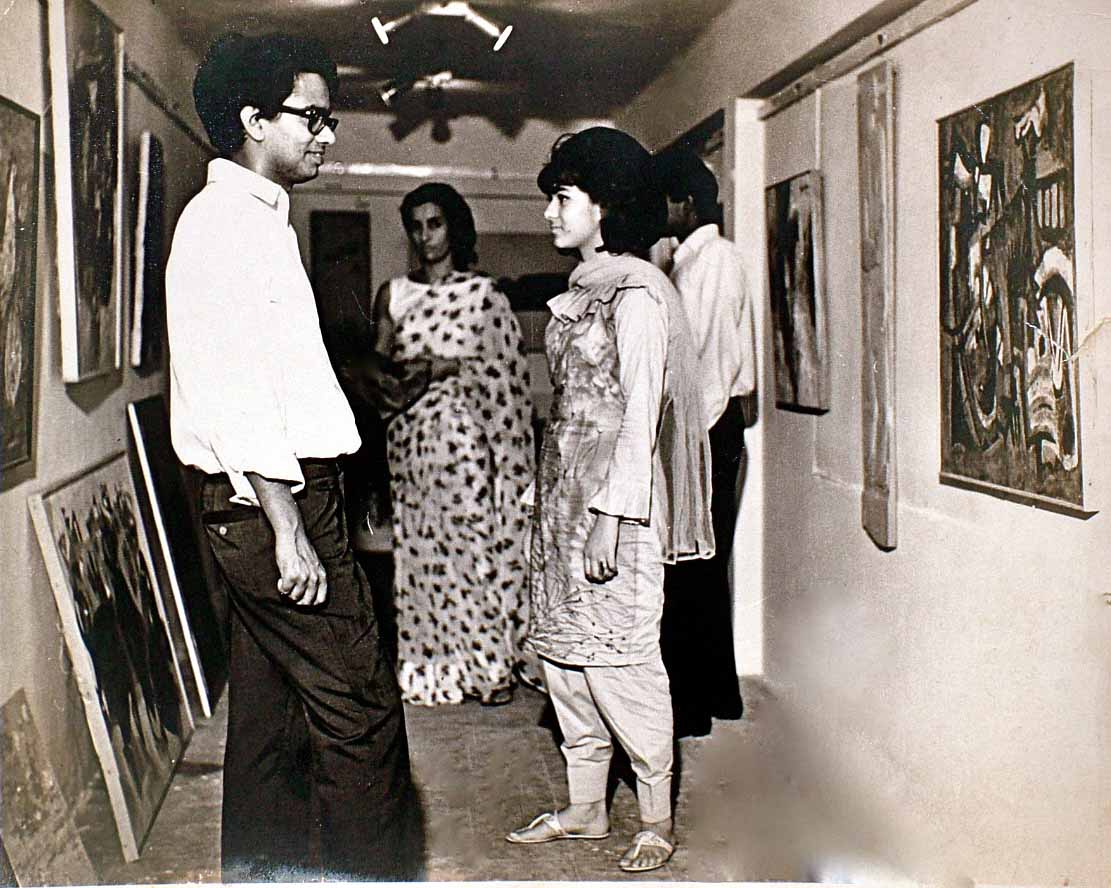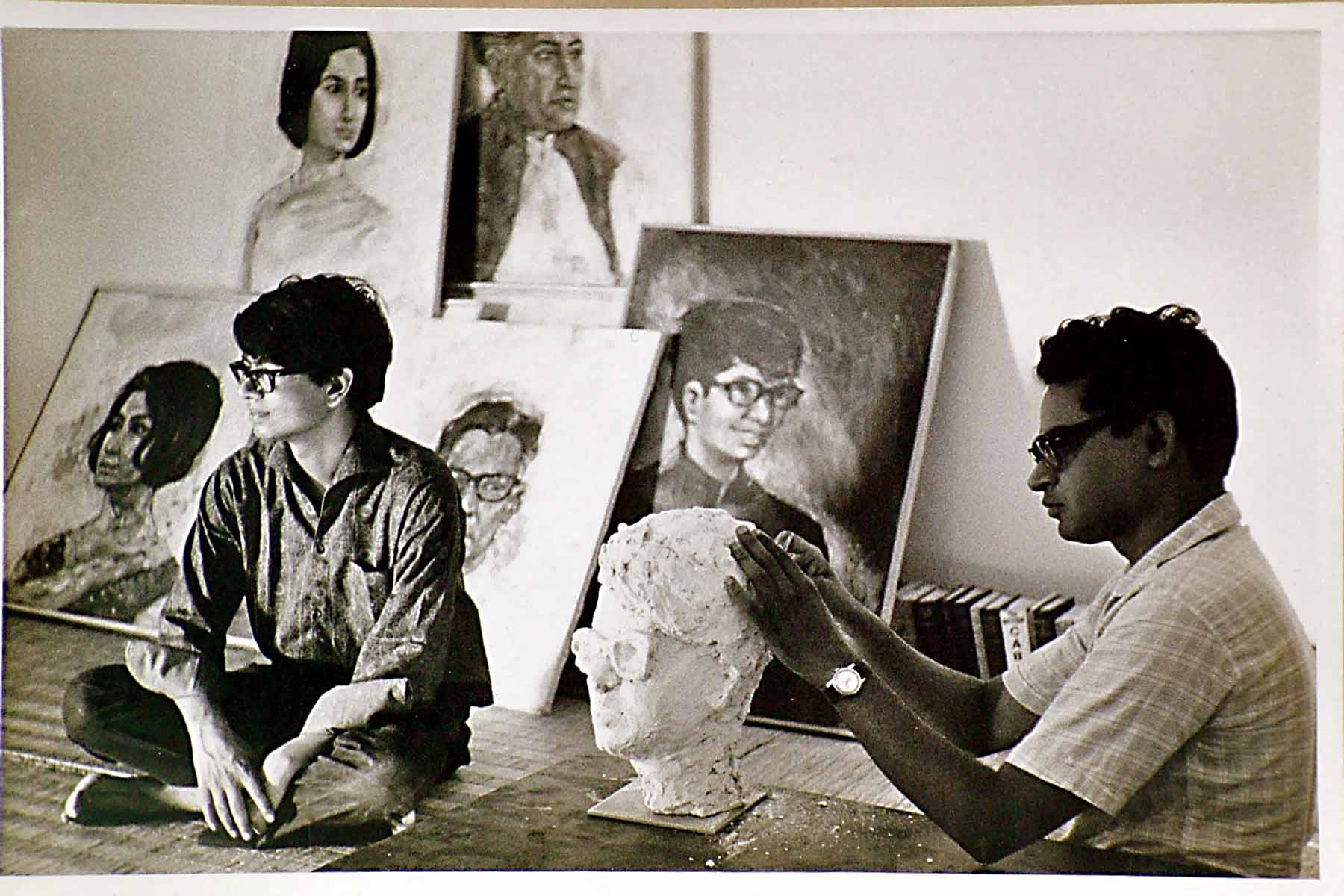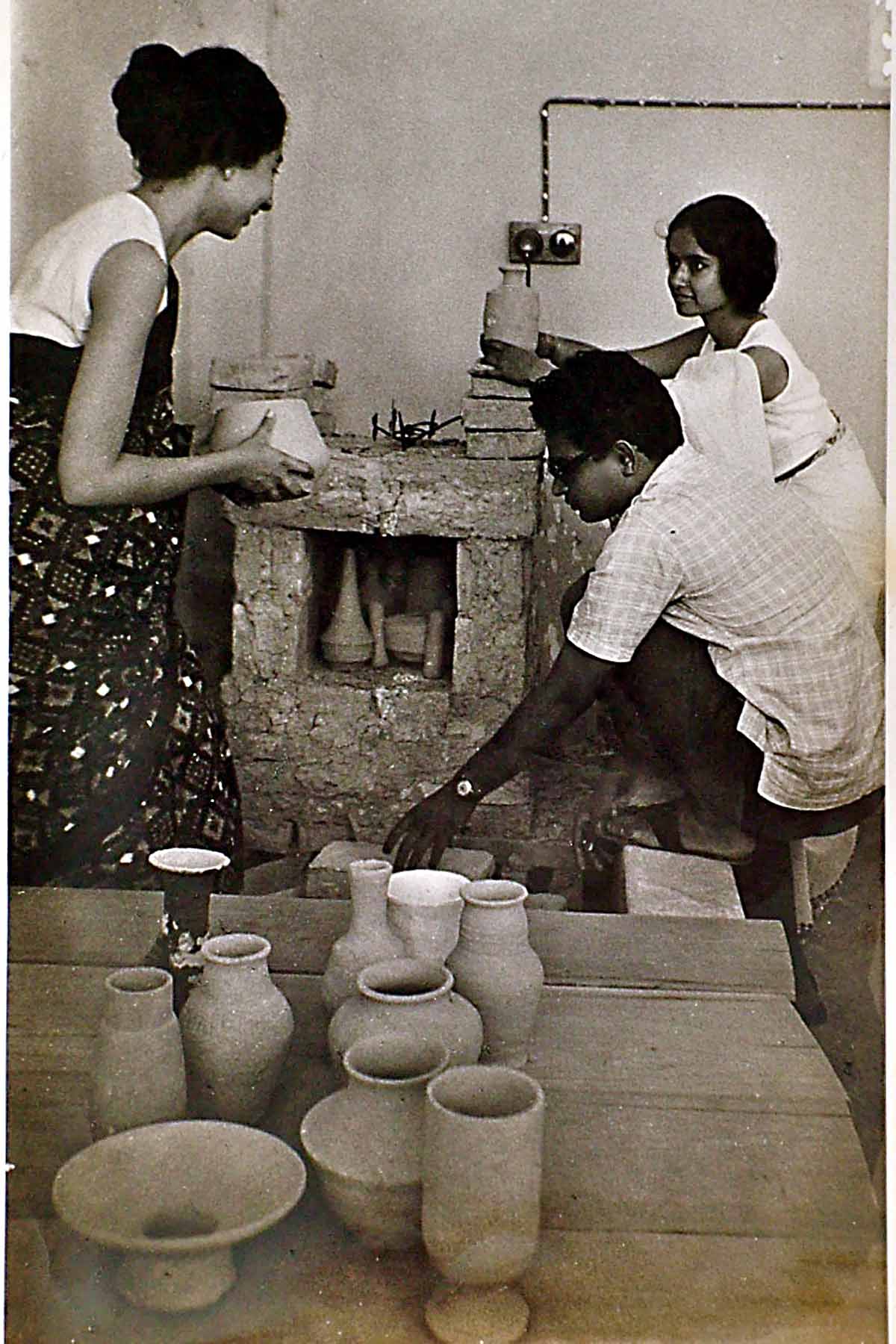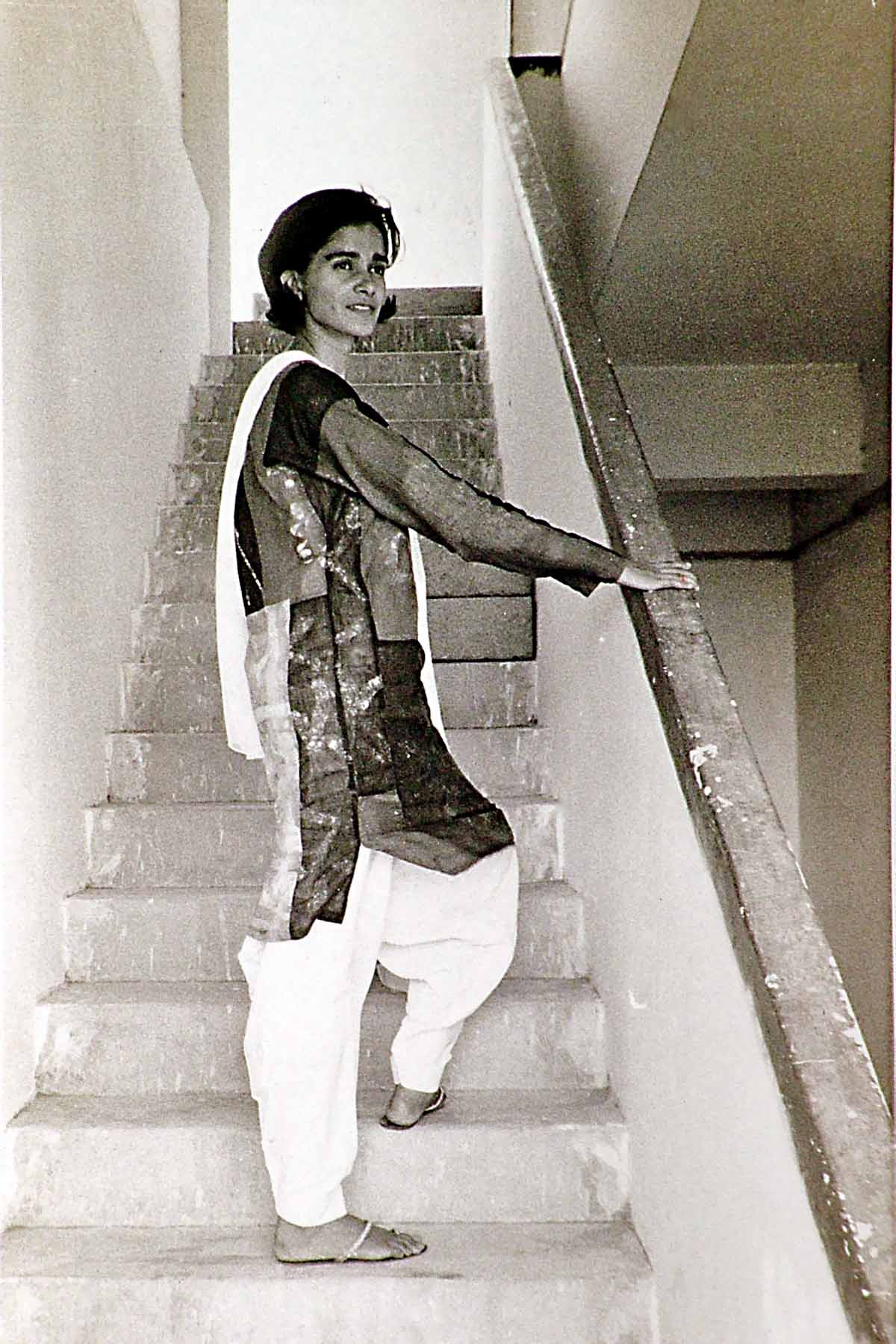Karachi Artists’ Gallery
When we came back from Oxford in 1963, my wife had her office in Qamar House while mine was in Muhammadi House. At that time these were the two most prominent office buildings of Karachi, and the Muhammadi House restaurant was a well-known eating-place, where my wife joined me for lunch, which was unusual for women to do in those days. It attracted artists who were employed in advertising companies with their offices in Muhammadi House and adjoining buildings. The artists complained to us that there was no art gallery where they could exhibit and sell their paintings, and that therefore they were forced to earn their living by working in offices doing various commercial work. I offered them a large room opening into our garden in PECHS, where we lived to establish their art gallery and studio for avant guard films. Artists Mansur Aye and Muhammad Ali worked hard, and we created the first art gallery in Pakistan in the name of Karachi Artists’ Gallery (KAG). After some time I was able to offer an eighty-foot long gallery in Lari Building in MAMCH Society, to which we had moved. Soon various artists began to use this as their studio, as they found it more congenial to work among their fellow artists rather than at home, as in those days modern art was not appreciated in most homes.
The KAG manifesto declared that things around us are not given as in nature. We live in a designed world. Everything we use or make has a design, be it crude or subtle, ugly or beautiful. If we are surrounded by ugly, gawky, or shabby things, it is because we tolerate them. They are neither God-ordained nor God-given. The tawdriness and frippery of our design, the tremendous waste and the frightful squalor of our urban surroundings, the frills and furbelows of our public and private buildings, the gaudy and grotesque décor of their interiors, either appeals to or disgusts a lot of us, but only the artist in us can aspire to improve and change.
It was in this spirit that Yasmeen Lari designed, Mansur Aye modeled, Mohammad Ali drew, and Siddiqua Bilgrami invented a new calligraphy. Siddiqua Bilgrami also suggested ceramics, and the affair of pottery began. Husbanallah designed the kiln; Mansur Aye and Muhammad Ali built. Muhammad Ali gave demonstrations on silk-screen printing. Mansur Aye, Anwar Maqsood, Masood Kohari, Mustafa and Muhammad Ali painted on tiles. Yasmeen Lari designed furniture, flower vases, egg cups out of wood. Rehana Fakih displayed her skills in batik, and a host of other artists joined in. A new fashion was created out of the fragments of an afternoon of exciting batik work, and we showed avant-garde films made in France, Italy and Japan after the War.
Writer and novelist, Professor Ahmed Ali, declared in the KAG journal that ‘the essential quality of the act of interpretation and creation, both of emotion and of the work of art, lies within. Why most works of art fail in our society is because of essential weakness of personality. It’s the man behind it that makes a painting a work of art. If he is missing, then art too is absent from the work. At best it will remain an attitude, and attitudes change and do not last. It’s personality alone that counts’.
Editor and writer Sultan Ahmed quoted Andre Malraux to say that ‘Art is the religion of the twentieth century man. It is art that distinguishes one people from another, one age from another’. Sultan Ahmed wrote that ‘In Mansur Aye and Muhammad Ali we have two remarkable, gifted and devoted painters who are held back by nothing. They explore the world of art with all the excitement of the young and the eager, and seek to make their distinct contribution to it. In Yasmeen Lari, who studied in Oxford, we have a very original architect who tries to break away from the conventions and clichés of the times, and lays every brick in style. And her concept of architectural beauty fortunately is not confined to the frames and walls of the house but to every aspect of a house within and without. In Naz Ikramullah we have a young painter who has seen a great deal of the world. A student of the London’s famous Slade School of Art, she has notable gifts and distinct promise. And in Siddiqua we have a notable abstract painter and with varied promise who studied art in Italy. Working with them will be a number of other artists, young and elderly, through casual visits or constant, to bring a vast totality of talent in their undertaking. When such gifted people take to painting, glazed pottery, designed by themselves, sculpture, silk-screen painting, furniture designing, litho printing, etc. etc., and all these go along with frequent group discussions, art film shows, art classes etc. the result cannot but be wholesome.’
Siddiqua wrote, ’Abstract art is world art- that is; geographical boundaries have not confined it to any one region. The world and its people are so closely knit in this present age that they find it quite natural to borrow each others’ way of dressing, of expressions in speech, of manners and thought and many other things. If we would only lift ourselves from the pit of petty-thinking, we would find our homes to be a far vaster world, unrestricted by regional, political and other boundaries of narrow-mindedness, egoism and many such chains of restricted thinking. The vast heritage of the world is ours, as also is its future’.
KAG also proposed that 10% of the cost of all public buildings should be allocated to artwork. Yasmeen Lari was able to persuade General Saeed Qadir, to allow Shahid Sajjad to do a bronze mural for the Armoured Corps Mess designed by her at Nowshera, and thus Shahid was able to switch from wood to a full scale bronze mural.
However she was not so successful with her next public project, because the general sold the land to a private party to build a hotel there. When she protested that the land was earmarked by Mr. Bhutto for her to create a centre for public companies nationalized by him, and which did not have sufficient office space of their own, the general offered another piece of land, provided that she could persuade public sector companies to fund the project proposed by her. She invited bureaucrats managing and controlling various nationalized industries to the Karachi Artists Gallery and in a series of meetings the Finance and Trade Centre (FTC) came into existence. Despite her repeated requests they were not prepared to allocate any funds for art work, although they were not concerned with the ever-increasing cost of the project, which to her great horror was daily mounting beyond her costing, but there was no stopping them. Therefore as proprietor of Lari Associates which employed my wife as the architect of the project, I wrote to all the bureaucrats who formed the committee that owned and managed the FTC. But I received no response, except from one Kunwar Idris who had led the police to attack and burn Liaquatabad market during the language agitation, and now wrote back to me that the cost of construction should be of no concern to the architect. Although the architect does all the detailed drawings, quantities, specifications and therefore is in the best position to supervise and control the cost.
Apart from our old friends, novelist Professor Ahmed Ali, poet Adrian Husain, there were scientist Dr. Salimuzzaman Siddiqui and his German wife, Tilly, who now and then brewed what they called Sharbat-i-Maudoodi, which was of interest to Sadequain. Begum Majeed Malik attracted literary figures like Faiz Ahmed Faiz, Sibte Hassan, Shanul Haq Haqqee and Begum Shaista Ikramullah. Dr. Shaukat Haroon came late in the evening after finishing her work, and so did Dr. Zainab Hasan who now lives and works in the USA. Other regulars were artist Naz Ikramullah, writer Muniza and her husband Saleem Shamsi, historian Zehra and her psychologist sister Meher Hasan. Our distinctive life style also attracted Begum Alys Faiz, who wrote for our friend Zohra Qureshi, the owner-editor of ‘She’ magazine. The son-in-law of Alys Faiz complaind to me that his mother-in-law had told him, ‘Why do you need money for furniture when the Laris can do without it?’. When Abdul Gamal Nasir of Egypt died, Faiz Saheb asked everyone to observe silence and asked me to put on Beethoven’s ‘Heroic Third Symphony’ and ‘Fifth Destiny Symphony’ composed on the rise of Napoleon Bonaparte.
We continued our Oxford habit of floor living with no furniture, except that now we had chattai (matting) from Chittagong on the floor, with a layer of thick felt underneath, and had open house every Sunday with a menu of puri, kabab, bhujia and dahibare made by our charas-smoking old cook, who one day went for a holiday and did not come back. Instead, his cousin came to say that he had died and that the family required money for his tajhis wa takfin (burial), which we gave, along with his pay. But fortunately the cook himself came back after a few months, saying that he had not died and merely needed a long holiday. During his absence and after his death a few years later, our maidservant from Nakhlau (Lucknow) with the help of her daughters held the fort. Sometimes our eminent scientist Dr. Salimuzzaman Siddiqui joined in the Sunday cooking saying that only a chemist knows when and at what temperature things should be mixed to retain their taste.
Another interesting figure who came for lunch was JA Rahim whose late wife was a German artist. He had retired from government service in 1966 and was living near us. He was educated at Cambridge and Munich, was fluent in English, French and German and knew Greek, Arabic and Persian. He has served as Pakistan‘s ambassador to West Germany, Spain, Morocco, France and Belgium. Rahim talked in English with an accent which was not comprehended by most people therefore I often put Husban next to him who was deaf in one ear, and had the habit of smiling and nodding to anyone who sat next to his deaf ear. JA Rahim also used to hold after dinner lectures at his house on socialism where some of the PPP stalwarts used to go to sleep because of their inability to comprehend his mumbled English accent. JA Rahim was a great help when my wife working on the master plan of Karachi, opposed location of the Steel Mill by Russians on the west of Karachi, which she thought would pollute the air of the whole of Karachi, but was opposed by those who thought the Russians would not agree, and Pakistan would lose the Steel Mill. Therefore I contacted Faiz Sahib who agreed to sign a letter to the Russian government which I would draft, requesting them to shift the Steel Mill from the west of Karachi. The Russians agreed to the request of their Lenin Peace Prize winner poet from Pakistan, the great Faiz Ahmed Faiz, and Karachi was saved from a great health hazard.
Our floor living attracted many people, because as long as they were prepared to sleep on the floor we could accommodate them. One of them was Shakir Ali, who was Principal of the National College of Arts in Lahore, and came with his friend Sibte Hasan. One day Shakir went to sleep in one corner of our drawing room, and stayed on and did a mural for us. A chemistry doctor working in a well known pharmaceutical company often came with his sensitive English wife to see him paint, and brought cans of wine which he himself had made. Shakir Ali took her away to Lahore but the relationship did not last long and she returned to her husband who took her to London, where they lived together till he died.



